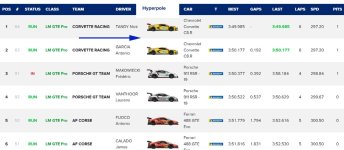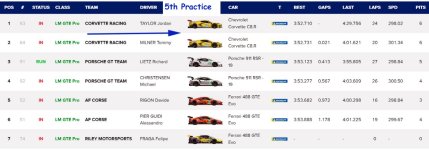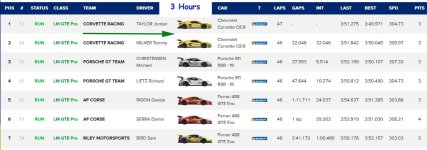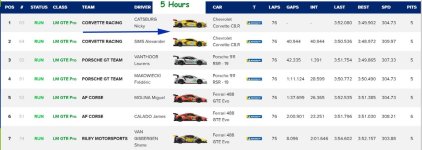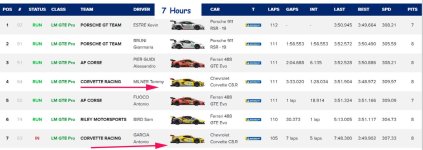Corvette Racing heads into its 22nd consecutive 24 Hours of Le Mans seeking its first win for the C8.R and the first since 2015. With the two cars in the hands of Tommy Milner, Nick Tandy and Alexander Sims (No. 64); and Antonio Garcia, Jordan Taylor and Nicky Catsburg (No. 63) starting one-two, Corvette has a good chance to achieve 24 Hours of Le Mans victories for all four generations of car it has taken to Le Mans.
Explore the history of Corvette Racing’s success in the American Le Mans Series and IMSA sports car championships in North America, and at Le Mans, across generations of cars and in different classes. Much of that success comes down to continuous improvement with each generation, General Motors and Pratt & Miller working together taking the lessons learned from one version of the racecar to apply to the next generation of road car to produce a better racecar. Win and repeat.
“The people working behind the program are the ones that really make this happen,” says Garcia. “So when you have GM and Pratt & Miller together, I think it proved to be an excellent combination. Pratt & Miller never stopped improving, and over the years, developing and using year by year the new tools available.
So if you look back to the very first Corvette to the very last one, I mean, all the resources put into each of them over the years have changed a lot.”
Pratt & Miller had a pretty good platform to work with in the C5, but it was far from ideal. Pop-up headlights and the cat-whisker air intakes weren’t what the car needed for success, especially at Le Mans.
“Corvette C5 was a Dave Hill-engineered project, which was the first proper technology, advanced materials and processing Corvette,” says Doug Fehan, the longtime Corvette Racing program manager who now serves in an ambassadorial role. “It was going to be a great car, because it was going to be completely different, clean sheet of paper, ground-up, everything-new kind of thing. And Herb [GM Racing head Herb Fishel] and I had developed a want and willingness to compete at Le Mans on the global stage with Corvette.”
Fehan, who first presented the idea of a racing program that would be much more than a win-on-Sunday, sell-on-Monday proposition in 1996, kept an office at Pratt & Miller, and credits the engineering expertise of Gary Pratt and the business sense of Jim Miller with much of the success of the program over the years. GM had previously worked with the company on the Intrepid GTP program, and Fehan describes the company in the early days as eight guys and a pickup truck.
Now known as Pratt Miller, the company was recently sold to Oshkosh Defense for $115 million. While defense projects will make up a large portion of the company’s work, Corvette Racing is still a key part of the business, and the company will develop the GT3 version of the C8 that will debut in 2024.
With the Intrepid experience in hand, Fehan though Pratt & Miller would be the ideal partners for developing Corvette into a world-beating race car.
But as good a car as the C5 was, and it was a big leap from the C4, Pratt & Miller still had its work cut out for it.
“We inherited a C5, the race team had no input into the design of the C5, it was done when we got it. And it was a great vehicle, but it had some real challenges in making it a racecar.
If you remember C5, you know it had those little cat whisker air intakes in the front grill, and it took in air from underneath the car. It made it really, really challenging to get enough combustion air into the engine, engine-cooling air and brake-cooling air utilizing that body design,” Fehan explains.
Despite that, the team achieved three wins at Le Mans with the car.
Corvette engineer Dave Hill then listened to what the race team had to say about that car, and Fehan notes that Hill thought he could use what was learned in racing to make a better road car, that in turn would be a better race car.
“When C6 was on the pad, which was about the time that we started racing, Corvette Chief Engineer Dave Hill, says, ‘Well, what do you need?’
I said I need a big, single air intake. I need the windshield tipped back as far as you can tip it back.
I need headlights that don’t flip up I need flush mount headlights, which was heresy. He gave us that.”
The flush headlights were a bigger deal than might be imagined. From C2 through C5, Corvette had always had some kind of flip-out or flip-up headlights. But with HID lighting coming, which required transformers and a bunch of other stuff to work, the time was right to do away with that.
C6 was an immediate success, giving Corvette its second and third 24 Hours of Le Mans victory in a row, with four victories overall, and four more consecutive American Le Mans Series championships. The partnership in evolving the Corvette between race team and production team continued.
“C7 had what we call the waterfall hood. Radiators in cars were always straight up and down, which was kind of made it a problem to get the air funneled through. You wanted that radiator canted forward and in C7 we were able to get that radiator canted forward and create that smooth air flow up through that radiator then out through the top of the hood. That was a direct derivative from racing,” Fehan says.
“And then all the stuff that you don’t see the components, the materials, the lightweight bodywork. All those things that we were developing in racing, were being looked at by the production design team. Getting the bottom of the car perfectly flat and smooth, to get the air to move out from underneath it more rapidly, they were learning that in racing.
Pratt & Miller was doing a lot of the computational fluid dynamics on the racecar, and they ended up helping GM do some CFD work on the Corvette bodywork. And that gave us the C7 (main image) which was a pretty kick-ass racecar and a tremendous road car.”
During all this, Tadge Juechter was observing. Not yet the man in charge, he had seen the trials and tribulations as Corvette evolved. But he would be tasked with overseeing perhaps the biggest evolution in the car’s history, the transition from front-mid engine to having the LT2 engine behind the driver. And there is a valid argument to be made that without Corvette Racing’s years of success when the green light was given, that C8 doesn’t exist in its current form.
“Tadge knew that this was going to be a pretty tall mountain to climb, because his goal was that, for the first time, we were actually going to work hand in glove, the race car design guys and the production team guys, were going to work together to design and build this C8.
And we were going to do it at a level heretofore unknown, really by anybody, any manufacturer. Tadge was committed, and he was a just a pitbull, getting stuff done that we needed to have happened. And the results are pretty stunning,” notes Fehan, his enthusiasm for the results clear in his voice.
“Tadge was a guy who was damn the torpedoes, full speed ahead. He was going to get this done, and he championed that thing. That’s why the car is just as good as it is. That, for me, from that 1996 presentation, is the car that embodies every single thing I would have ever dreamed or envisioned what a race program could do. It’s really the final distillation of 25 years of tremendous effort on everybody’s part,” sums up Fehan.
For the 2022 season, Corvette is splitting its efforts, running a modified version of the C8.R in GTD Pro in the IMSA WeatherTech SportsCar Championship and the C8.R GTE car in the full World Endurance Championship.
Both programs came together at Daytona, and are together again for the 24 Hours of Le Mans. Sunday will reveal whether the final version of the GTE car is victorious at Circuit de la Sarthe, and the C8 can count a Le Mans win on its resume, before the GT3 era begins.
